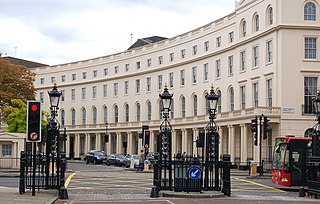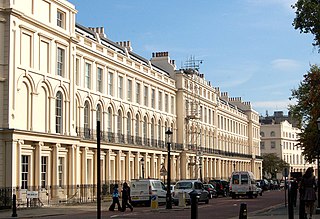 W
WRegent's Park is one of the Royal Parks of London. It occupies high ground in north-west Inner London, administratively split between the City of Westminster and the Borough of Camden. It contains Regent's University and London Zoo.
 W
WBedford College was founded in London in 1849 as the first higher education college for women in the United Kingdom. In 1900, it became a constituent of the University of London. Having played a leading role in the advancement of women in higher education and public life in general, it became fully coeducational in the 1960s. In 1985, Bedford College merged with Royal Holloway College, another constituent of the University of London, to form Royal Holloway and Bedford New College. This remains the official name, but it is commonly called Royal Holloway, University of London (RHUL).
 W
WCambridge Terrace is a row of consecutive terraced mansions overlooking Regent's Park in the London Borough of Camden, London, England. The terrace has been Grade I listed since 1974.
 W
WChester Terrace is one of the neo-classical terraces in Regent's Park, London. The terrace has the longest unbroken facade in Regent's Park, of about 280 metres (920 ft). It takes its name from one of the titles of George IV before he became king, Earl of Chester. It now lies within the London Borough of Camden.
 W
WClarence Terrace overlooks Regent's Park in Marylebone, City of Westminster, London, England. This terrace is the smallest in the park. The terrace is a Grade I listed building.
 W
WCornwall Terrace is a Grade I listed building of consecutive terraced mansions overlooking Regent's Park in the City of Westminster, London. It is situated at the park's southwest corner, near Baker Street, between York Terrace and Clarence Terrace, within the park's Crown Estate development. Cornwall Terrace was part of the scheme of the Prince Regent, later King George IV, to develop grand housing in Regent's Park. The buildings are Grade I listed buildings.
 W
WThe Crown Estate Paving Commission (CEPC) is the body responsible for managing certain aspects of the built environment around Regent's Park, London. It was established by statute in 1824. It fulfills some local government functions, and is one of the few bodies in the United Kingdom still empowered to levy rates on residential property. Although it has local government functions and tax-raising powers, its members are not elected but are appointed by the Lords of the Treasury. It is a separate body from the Crown Estate, which holds the freehold of Regent's Park.
 W
WCumberland Terrace is a neoclassical terrace on the eastern side of Regent's Park in the London Borough of Camden, completed in 1826. It is a Grade I listed building.
 W
WHanover Terrace overlooks Regent's Park in City of Westminster, London, England. The terrace is a Grade I listed building.
 W
WHolford House was a large residential building in the Regent's Park in London. It was used at various times in its history as a private residence and an educational college for Dissenters before being destroyed by a German air raid in 1944.
 W
WThe Holme is a mansion located on Inner Circle by Regent's Park in the City of Westminster, London, England. It was designed by Decimus Burton, as a residence for the Burton family, and built in 1818, by the company of James Burton, who subsequently lived there. It has been described as 'one of the most desirable private homes in London' by architectural scholar Guy Williams. Architectural critic Ian Nairn wrote of the house, "If you want a definition of western civilization in a single view, then here it is".
 W
WThe Hyde Park and Regent's Park bombings were carried out on 20 July 1982 in London, England. Members of the Provisional Irish Republican Army (IRA) detonated two bombs during British military ceremonies in Hyde Park and Regent's Park, both in central London.
 W
WInternational Students House, London is a set of lodgings for 700 British and overseas students in London. It permanently occupies two large buildings in streets one short block south of Regent's Park, one of which, the headquarters, faces Park Crescent which in turn across a square green faces the park itself.
 W
WThe London Central Mosque is an Islamic place of worship located on the edge of Regent's Park in central London.
 W
WThe London Green Fair was an event that has been held on the first Sunday in June in Regent's Park in London, England, coinciding with World Environment Day. Founded in 1982, the Fair aimed to inspire Londoners to help make their capital a world-class green city, letting visitors find out about sustainable companies, products, campaigns, and lifestyle choices.
 W
WLondon Zoo is the world's oldest scientific zoo. It was opened in London on 27 April 1828, and was originally intended to be used as a collection for scientific study. In 1831 or 1832, the animals of the Tower of London menagerie were transferred to the zoo's collection. It was opened to the public in 1847. Today, it houses a collection of 673 species of animals, with 19,289 individuals, making it one of the largest collections in the United Kingdom. The zoo is sometimes called Regent's Zoo.
 W
WPark Crescent is at the north end of Portland Place and south of Marylebone Road in London. The crescent consists of elegant stuccoed terraced houses by the architect John Nash, which form a semicircle. The crescent is part of Nash's and wider town-planning visions of Roman-inspired imperial West End approaches to Regent's Park. It was originally conceived as a circus (circle) to be named Regent's Circus but instead Park Square was built to the north. The only buildings on the Regent's Park side of the square are small garden buildings, enabling higher floors of the Park Crescent buildings to have a longer, green northern view.
 W
WPark Square is a large garden square or private appendix to Regent's Park in London and is split from a further green, the long northern side of Park Crescent, by Marylebone Road and (single-entrance) Regent's Park tube station. It consists of two facing rows of large, very classically formed, stuccoed, terraced houses with decorative lower floor balconies and a colonade of consecutive porticos by architect John Nash, and was built in 1823–24. Alike, shorter-length terraces flank its corners at right angles, equally Grade I listed buildings: Ulster Terrace, Ulster Place, St Andrew's Place and Albany Terrace.
 W
WRegent Street is a major shopping street in the West End of London. It is named after George, the Prince Regent and was laid out under the direction of the architect John Nash and James Burton. It runs from Waterloo Place in St James's at the southern end, through Piccadilly Circus and Oxford Circus, to All Souls Church. From there Langham Place and Portland Place continue the route to Regent's Park.
 W
WRegent's Park Open Air Theatre is an open-air theatre in Regent's Park in central London.
 W
WThe Regent's Park skating disaster occurred on 15 January 1867 when 40 people died after the ice broke on the lake in London's Regent's Park pitching about 200 people into icy water up to 12 ft (3.7 m) deep. Most were rescued by bystanders but 40 people died either from hypothermia or by drowning. The incident was considered at the time to be the worst weather related accident in Britain. One of the consequences of the incident was that Regent's Park lake was raised and reduced to a maximum depth of 4 ft (1.2 m).
 W
WRegent's Park is a London Underground station 175 m south of Regent's Park. It is on a northern cusp of Fitzrovia and Marylebone on the Bakerloo line, between Baker Street and Oxford Circus. Its access is on Marylebone Road, within Park Crescent, in Travelcard Zone 1, in which zone it is the second-least used station – it saw 3.5 million entries or exits in 2015. It is 175 m west of Great Portland Street tube station on the same arterial road.
 W
WSt John's Lodge is a Grade II* heritage-listed private residence located in Regent's Park, in the City of Westminster, London, England. Since 1994 it has been owned by the royal family of Brunei Darussalam and is the London home of Prince Jefri Bolkiah of Brunei. St John's Lodge is located on the Inner Circle of Regent's Park, which until 1965 was in the Metropolitan Borough of St Marylebone and is now part of the City of Westminster.
 W
WYork Gate is an entrance to Regent's Park, London designed by John Nash in 1822. It separates the east and west parts of York Terrace. It was designed as five separate houses.
 W
WYork Terrace overlooks the south side of Regent's Park in Marylebone, City of Westminster, London, England. York Terrace West is a grade I listed building. York Terrace East contains Grade II listed buildings. 1-18 York Terrace East is listed Grade I.